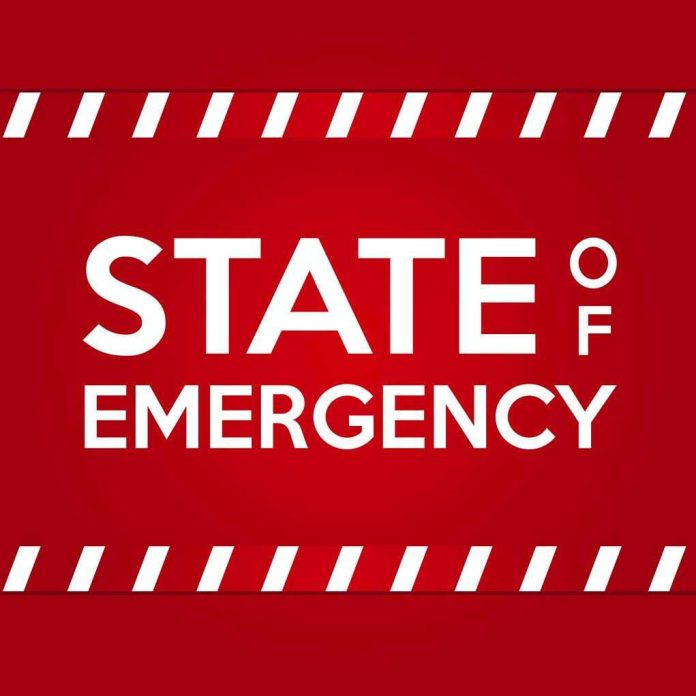
When a typhoon delivers the worst flash floods in Cebu’s history and forces a nation into emergency mode, you realize that disaster isn’t just news—it’s a test of resilience, leadership, and common sense.
Story Snapshot
- Typhoon Kalmaegi triggered a nationwide state of calamity after catastrophic destruction and historic flooding.
- Over half a million people were displaced as the typhoon made multiple landfalls across densely populated regions.
- Government response mobilized rapidly, but exposed critical vulnerabilities in disaster preparedness.
- Questions linger about climate adaptation, infrastructure resilience, and the adequacy of crisis management.
Typhoon Kalmaegi’s Path of Destruction
Typhoon Kalmaegi, locally named Tino, swept across the central Philippines on November 4, 2025, intensifying as it barreled ashore in Southern Leyte. Within twenty-four hours, it unleashed chaos across Cebu, Negros Occidental, Guimaras, Iloilo, and Palawan. The storm’s erratic path delivered repeated blows, overwhelming local authorities and catching even seasoned disaster responders off guard. Flash floods in Cebu reached record-breaking levels, leaving city streets underwater and stranding thousands in ports and airports.
By November 6, the death toll climbed to at least 142, with 127 missing and over 82 injured. More than 1.9 million individuals found themselves affected, and over half a million were pushed from their homes. Power outages struck 1.4 million households, and roads, bridges, and airports became impassable, paralyzing vital infrastructure. For many, the only certainty was uncertainty—no one knew when help would arrive or how extensive the damage would be.
Government Response and Leadership Under Pressure
President Bongbong Marcos declared a nationwide state of calamity, mobilizing government agencies and humanitarian teams at unprecedented speed. The National Disaster Risk Reduction and Management Council (NDRRMC) coordinated rescue operations while local governments scrambled to evacuate families from rising waters. In Cebu, Governor Pam Baricuatro called the flooding “the worst ever caused by a typhoon.” Mayors and health officials issued code white alerts, deploying medical teams and urging people to seek shelter.
Despite rapid response, the magnitude of the disaster exposed deep-rooted weaknesses. Many communities were still reeling from an earthquake earlier in the year. Pre-existing vulnerabilities—aging infrastructure, limited evacuation resources, and gaps in early warning systems—amplified the devastation. The government’s swift declaration of calamity signaled seriousness, but also highlighted the relentless cycle of natural disasters and the need for sustainable, long-term solutions.
Humanitarian Crisis: Displacement, Trauma, and Recovery
Kalmaegi’s aftermath is more than numbers and headlines. Entire villages in Cebu, Iloilo, and Palawan were submerged, with survivors huddled in overcrowded evacuation centers. Children, elderly, and low-income families faced immediate threats: contaminated water, disease outbreaks, and loss of livelihoods. Schools shut their doors, businesses paused, and uncertainty hung in the air. Trauma rippled through communities, as families searched for missing loved ones and wondered how to rebuild.
Relief teams raced against time, clearing debris, restoring power, and distributing food and medical aid. Yet, the scale of displacement—over 562,000 people—underscored the urgent need for better housing, healthcare, and social support. The economic toll mounted, with agricultural losses exceeding ₱13.26 million (US$269,238) and government budgets stretched thin by emergency spending. Recovery would not come quickly, and for many, the path forward remains uncertain.
Lessons Learned: Climate, Preparedness, and Conservative Values
Experts point to two hard truths. First, Kalmaegi’s unusual intensity and multiple landfalls reflect a broader trend: climate change is making typhoons more unpredictable and severe. Second, the disaster exposed the limits of current crisis management. Meteorologists and disaster planners call for robust early warning systems and resilient infrastructure—especially in urban, flood-prone areas. Academics argue that climate adaptation must become central to urban planning, not just a distant priority.
From a conservative, common-sense perspective, the calamity drives home the importance of preparedness, accountability, and community values. Resilience requires more than government declarations—it demands practical investments in infrastructure, responsible leadership, and a culture of readiness. The Philippines faces a crossroads: repeat the mistakes of the past or build a future where storms test, but don’t break, the nation’s spirit.
Sources:
Wikipedia: Typhoon Kalmaegi (2025)













